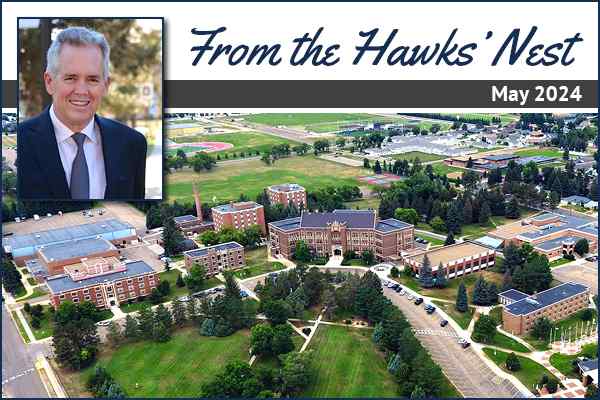Theodore Roosevelt is quoted as having said, “The more you know about the past, the better prepared you are for the future.” The proposed campus renewal project drafted by Dickinson State University respects its historical roots while embracing modern advancements, preparing the institution and its students for future challenges and opportunities.
As the President of DSU, I am excited to advocate for the substantial state support needed to make this ambitious project the gateway to the future for our beloved “College on the Hill.” This initiative aligns with our strategic goals to enhance academic offerings and address critical infrastructural deficiencies while positioning DSU as a leader in innovative and inclusive education.
As those familiar with DSU’s founding as a teacher education institution (originally known as “Dickinson Normal School”) know, providing high-quality education is our core mission. Based on that core initial goal of teaching our region’s K-12 teachers, the proposed School of Education Center for Teaching and Learning Excellence would advance this mission while providing other assets for DSU and our community.
If we are blessed to receive funding through a generous allocation from the North Dakota Legislature working on behalf of taxpayers, this facility would house state-of-the-art simulated classrooms, special education training spaces, and an early childhood education center, all designed to provide hands-on learning experiences for current and future educators. By equipping our students with cutting-edge resources and immersive learning environments, we will prepare them to excel and contribute meaningfully to our communities.
Moreover, the proposed transformation of Stoxen Library into an Academic Success Center exemplifies our dedication to fostering an environment where learning and research thrive. This modern facility would provide flexible learning spaces, advanced technological resources, and comprehensive academic support services. It would be a hub for student collaboration and innovation, significantly enhancing the college experience for DSU students.
The current state of some of our campus buildings, notably Stickney Hall and Selke Hall, poses significant challenges. Stickney Hall, constructed in 1921, and Selke Hall, built in 1960, suffer from structural, electrical, and mechanical deficiencies that make renovations cost-prohibitive. In addition to being inefficient and expensive to maintain, these buildings fail to meet modern standards for accessibility, a significant priority on our campus.
While it is never easy to say goodbye to old friends, the demolition of Stickney and Selke Halls would substantially reduce our maintenance burden, which is a severe drain on taxpayer and campus resources. Also, current state requirements encourage the reduction of physical footprint for more modern and efficient designs.
Though we hope to convince the Legislature to support this project, it is important to realize that we cannot engage in it without that support. Thus, despite suggestions by some to the contrary, there is no current plan to remove Stickney and Selke Halls from our campus. At this point, we are asking for the state support needed to make this project happen.
In our efforts to secure that funding, we will point to history. To the best of our knowledge, the last building constructed via state funding at DSU was the original Agriculture Building in the early 1980s. Although the state has supported the renovation of DSU buildings, it has not constructed a new DSU building in four and a half decades. Because the state has constructed several buildings on other North Dakota campuses in that (almost) half-century, we hope the Legislature will conclude that it is DSU’s turn for a major construction project.
Letting go is hard, but the potential ahead gives us much to be excited about. The new Center for Teaching and Learning Excellence, which would replace Selke Hall, would feature accessible design elements, ensuring that all students, including those with disabilities, can fully participate in academic activities. The installation of a ground source heating and cooling system would modernize our campus infrastructure, providing a more sustainable and cost-effective solution for our energy needs. Importantly, the new Center would still provide housing for students, both in the summer months and during the regular academic year.
In addition to serving DSU students, the new Center for Teaching and Learning Excellence would also function as a community resource. The early childhood education center would offer high-quality preschool programs and childcare services, addressing a critical need in Stark County. The enhanced facilities would also support a wide range of professional development opportunities for current educators. With dedicated spaces for in-service training, workshops, and seminars, the new Center would boost DSU’s status as a regional hub for teacher education, helping our state and region address the teacher shortage challenging our colleagues in K12 education.
Another critical aspect of the project is the improvement of campus safety and accessibility. The proposed indoor connection between May Hall and the Student Center, along with the renovation of the tunnel system, would provide a safe, wheelchair-accessible, and pedestrian-friendly route for students, faculty, and staff. This development is particularly important during the harsh winter months, reducing the risk of accidents on our treasured but sometimes slick “Hill,” so all members of our community can navigate the campus safely and comfortably.
By replacing beloved, but outdated, buildings with state-of-the-art facilities, the proposed campus renewal project would address critical infrastructure issues, enhance academic offerings, and foster a community that values accessibility and engagement. We are excited about this opportunity to improve the Hawks’ Nest into a modern, inclusive, and innovative educational environment for our community and region.

